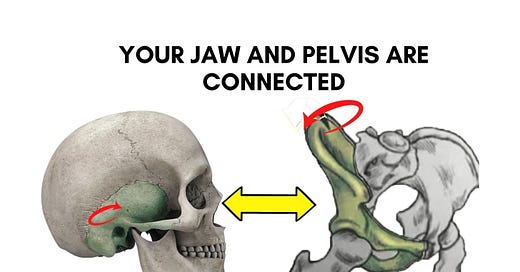YourJaw And Pelvis Are Connected
When your jaw is off, your neck tightens, your hips shift, and your whole body starts to feel uneven.
If you’re wondering how something as small as your jaw could influence something as far away as your pelvis, it’s because the body doesn’t move in straight lines it moves through postural chains.
We’re used to thinking in terms of isolated joints and muscles. But the nervous system doesn’t operate in parts. It processes input globally. The jaw is tied into some of the brain’s most influential control centers for posture and muscle tone. Through the trigeminal nerve, it feeds directly into the brainstem, influencing how your head sits on your spine.
In this post, you’ll learn how jaw position reshapes your neck input, how that input influences your brain’s control over posture, and why rebalancing the jaw can unlock strength, stability, and even pelvic function from the top down.
When the jaw becomes imbalanced from poor tongue posture, whether from, dental work, or missing teeth, it creates asymmetrical tension in the deep muscles of the neck.
These muscles, including the longus colli and longus capitis, are packed with mechanoreceptors.
Their job is to tell your brain exactly where your head is in space.
But if the muscles are pulled off-center, the information they send is distorted. And the brain doesn’t guess. It adapts. It tightens muscles elsewhere to stabilize what it believes is unstable. That means your hips, spine, and even your feet may be compensating for a problem that started at the jaw.
That distorted neck input travels through two key pathways.
One goes to the external cuneate nucleus in the brainstem, which relays head and neck data to the cerebellum the part of the brain responsible for coordination and balance. →If this data is unclear, the cerebellum adjusts your posture to match the faulty input, often by hiking one hip, rotating the pelvis, or changing how you load each leg.
The second pathway runs through the central cervical nucleus in the upper spinal cord. This area manages tonic postural reflexes your background muscle tone. It determines how much activation your spine and core need to hold you upright. If the jaw is sending mixed signals, this nucleus redistributes tension throughout the body, often in ways that don’t feel logical. One glute shuts down. Your ribs shift. Your foot rolls in. You feel off, but you can’t explain why.
As the upper body compensates, the effects eventually reach the feet. Your feet don’t just support your weight they respond to how your brain is distributing that weight. When the jaw shifts, the neck adapts. That affects the spine. The spine adjusts the pelvis. And by the time that compensation reaches the ground, the feet are no longer absorbing force evenly they’re reacting to an altered map from above.
There’s a fourth, often overlooked effect too. When your jaw affects the neck, and the neck sends skewed input to the brainstem, it can interfere with how your autonomic nervous system functions. That includes your breathing, digestion, and even heart rate variability.
Here’s how: the same cervical input gets routed into the nucleus intermedius, which relays into the nucleus tractus solitarius. This area integrates sensory data from the internal organs and influences the dorsal motor nucleus of the vagus the output center for your parasympathetic system.
When that chain is disrupted, your body leans toward a stress state. Breathing becomes shallow. Digestion slows. Recovery feels harder. And you might never trace it back to the tension in your jaw and neck.
Get the full Course Pack, including the Brain Coach Performance Certification,
and learn how to correct posture at the source by addressing the nervous system,
not just the muscles. These courses give you the tools to understand the
body as a whole and change it, step by step. It all starts with the brain.
Recent research confirms that jaw mobility influences pelvic function and vice versa. In one study, a single session of TMJ soft-tissue therapy significantly improved pelvic floor muscle relaxation and contraction strength . Another investigation demonstrated that repositioning the jaw altered foot pressure patterns and pelvis positioning. (link to study).
These findings show that the jaw, pelvic floor, feet, and pelvis are connected through fascia and the nervous system. This explains why imbalance in one area often mirrors imbalance elsewhere and why addressing both sides together is essential for real, lasting change. (link to study).
The Jaw-Pelvis Reset Protocol
This four-step protocol restores proper communication from jaw to pelvis to foot. Each one activates high-priority areas in the brain that control posture reflexively. By resetting the input at the top, the body stops compensating below. Do it consistently, and the system resets.



